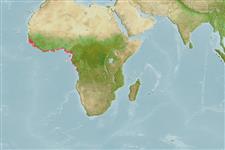Classification / Names
Common names from other countries
Main reference
Size / Weight / Age
Max length : 45.0 cm TL male/unsexed; (Ref. 5377); common length : 25.0 cm TL male/unsexed; (Ref. 26999)
Length at first maturity
Lm 17.0 range ? - 18.5 cm
Environment
Marine; freshwater; brackish; pelagic-neritic; catadromous (Ref. 51243); depth range 0 - ? m (Ref. 54436), usually 0 - 50 m (Ref. 54436)
Climate / Range
Tropical, preferred 27°C (Ref. 107945); 25°N - 8°S, 17°W - 14°E (Ref. 54436)
Distribution
Atlantic Ocean: Eastern central Atlantic Ocean from Dakhla in Western Sahara to Lobito Bay in Angola (Ref. 188, 81269, 81631). Reports from Cape Verde Islands are based on an erroneous type locality for Clupea fimbriata by Bowdich (1825) which was followed by later authors (Ref. 188).
Countries | FAO areas | Ecosystems | Occurrences | Introductions
Short description
Dorsal
spines
(total): 0;
Dorsal
soft rays
(total): 16-19;
Anal
spines: 0;
Anal
soft rays: 19 - 23. Diagnosis: Ethmalosa fimbriata is distinguished from other clupeids by the presence of a median notch on the upper jaw, into which tip of lower jaw fits (Ref. 188, 81269). A faint dark spot behind gill cover, sometimes followed by others; dorsal fin tip black; caudal fin deep chrome yellow; golden tints on body (Ref. 188). Ethmalosa fimbriata resembles Sardinella aurita, Sardinella rouxi and especially Sardinella maderensis, but these are more slender, have a rounded upper jaw which is not notched and the upper gillrakers are not bent upward like an elbow (Ref. 188).
IUCN Red List Status (Ref. 115185)
Threat to humans
Harmless
Human uses
Fisheries: highly commercial; aquaculture: experimental
More information
ReferencesAquacultureAquaculture profileStrainsGeneticsAllele frequenciesHeritabilityDiseasesProcessingMass conversion
Tools
Special reports
Download XML
Internet sources
Estimates of some properties based on models
Phylogenetic diversity index
PD50 = 1.0000 many relatives (e.g. carps) 0.5 - 2.0 few relatives (e.g. lungfishes)
Trophic Level
2.5 ±0.20 se; Based on food items.
Resilience
High, minimum population doubling time less than 15 months (K=0.25-0.36; tm=1; Fec=16,000)
Vulnerability
Low vulnerability (21 of 100)
Price category
